The Development of Spatial Sense in Two-Dimensional and Three-Dimensional Geometry Content by Using Van Hiele Model with Multimedia of Mathayomsuksa 1 Students at Yothinburana School
DOI:
https://doi.org/10.14456/educu.2024.37Keywords:
spatial sense, Van Hiele model, multimediaAbstract
The objective of this experimental research was to compare the development of spatial sense in two-dimensional and three-dimensional geometry content of Mathayomsuksa 1 Students using Van Hiele model as an assisting multimedia. The cluster random sampling method was used in the study, and the participants were 33 Mathayomsuksa first year students from 1/4 who were selected though cluster random sampling method in the first semester of the academic year 2022 at Yothinburana School. The tools used in the research include: 1) learning activities covering two-dimensional and three-dimensional geometry content, using Van Hiele model as an assisting multimedia, and 2) an achievement test on two-dimensional and three-dimensional geometry. The data was analyzed by percentage, arithmetic mean, standard deviation, and t-test for one sample. The research revealed that the development of spatial sense in two-dimensional and three-dimensional geometric content by using Van Hiele model as an assisting multimedia of Mathayomsuksa 1 Students after being taught in the lesson on in two-dimensional and three-dimensional geometry content by using Van Hiele model as an assisting multimedia was significantly higher (M = 23.86, SD = 2.58) than before studying (M = 18.12, SD = 3.89) at the statistical level of 0.1
References
ภาษาไทย
กระทรวงศึกษาธิการ. (2560). ตัวชี้วัดและสาระการเรียนรู้แกนกลาง กลุ่มสาระการเรียนรู้คณิตศาสตร์ (ฉบับปรับปรุง 2560) ตามหลักสูตรแกนกลางการศึกษาขั้นพื้นฐานพุทธศักราช 2551. โรงพิมพ์ชุมนุมสหกรณ์การเกษตรแห่งประเทศไทย.
เกณิกา กรกัญญพัชร. (2561). การศึกษาความรู้สึกเชิงปริภูมิของนักเรียนชั้นมัธยมศึกษาปีที่ 1 โรงเรียนสาธิตแห่งมหาวิทยาลัยเกษตรศาสตร์ ศูนย์วิจัยและพัฒนาการศึกษา เรื่อง ความสัมพันธ์ระหว่างรูปเรขาคณิตสองมิติและสามมิติ โดยการจัดกิจกรรมการเรียนรู้ตามแนวคิดของ Van Hiele. วารสารศึกษาศาสตร์ปริทัศน์, 33(1), 179-187.
จันทิมา แตงทอง. (2559). กิจกรรมการเรียนรู้วิชาคณิตศาสตร์ เรื่อง ทฤษฎีบทพีทาโกรัส โดยการใช้สื่อประสม ของนักเรียนชั้นมัธยมศึกษาปีที่ 2. [วิทยานิพนธ์ปริญญามหาบัณฑิต, มหาวิทยาลัยบูรพา]. Burapha University Research Information (BUUIR). https://buuir.buu.ac.th/handle/1234567890/11715
ชลดา ปานสมบูรณ์, น้ำผึ้ง ชูเลิศ, และ ธนวัฒน์ ศรีศิริวัฒน์. (2564). ผลการจัดการเรียนรู้วิชาคณิตศาสตร์ เรื่อง โจทย์ปัญหาเกี่ยวกับสมการเชิงเส้นตัวแปรเดียวโดยใช้กลวิธี STAR ร่วมกับสื่อประสม นักเรียนชั้นมัธยมศึกษาปีที่ 1. วารสารครุศาสตร์ จุฬาลงกรณ์มหาวิทยาลัย, 50(2), 1-11. https://doi.org/10.144456/educu.2022.15
ธนัชพร ตันมา. (2561). การศึกษาผลสัมฤทธิ์ทางการเรียน เรื่องเศษส่วน โดยใช้เทคนิคกลุ่มเพื่อนช่วยเพื่อนรายบุคคลร่วมกับสื่อประสม สำหรับนักเรียนชั้นประถมศึกษาปีที่ 4 - 6. [วิทยานิพนธ์ปริญญามหาบัณฑิต ไม่ได้ตีพิมพ์]. มหาวิทยาลัยราชภัฏอุตรดิตถ์.
ธิดารัตน์ คล้ายอักษร, และ ธนัชยศ จำปาหวาย. (2562). การแก้ปัญหาผลสัมฤทธิ์ทางการเรียน เรื่องพื้นที่ผิวของปริซึม โดยใช้สื่อประสม สำหรับนักเรียนชั้นมัธยมศึกษาปีที่ 3/4 โรงเรียนมัธยมวัดดุสิตาราม. วารสารวิชาการ ครุศาสตร์สวนสุนันทา, 3(2), 11-19.
เบญจมาศ หลักบุญ. (2560). การศึกษาผลสัมฤทธิ์ทางการเรียนวิชาคณิตศาสตร์ เรื่อง ความสัมพันธ์ระหว่างรูปเรขาคณิตสองมิติและสามมิติ ของนักเรียนชั้นมัธยมศึกษาปีที่ 1 โรงเรียนพรตพิทยพยัตโดยใช้สื่อประสม. [วิทยานิพนธ์ปริญญามหาบัณฑิต ไม่ได้ตีพิมพ์]. มหาวิทยาลัยรามคำแหง.
พิซิต ฤทธิ์จรูญ. (2556). หลักการวัดและประเมินผลการศึกษา. บริษัท เฮ้าส์ ออฟ เคอร์มิสท์ จำกัด.
ยุพิน พิพิธกุล. (2539). การเรียนการสอนคณิตศาสตร์. บพิธการพิมพ์.
สถาบันส่งสริมการสอนวิทยาศาสตร์และเทคโนโลยี กระทรวงศึกษาธิการ. (2554). การอบรมครูด้วยระบบทางไกลสาระการเรียนรู้คณิตศาสตร์ ระดับประถมศึกษาหลักสูตรมาตรฐานการอบรมครูปีที่ 1. ม.ป.ท.
สิริพร ทองมาลี. (2563). การพัฒนาผลสัมฤทธิ์ทางการเรียนวิชาคณิตศาสตร์ เรื่องรูปเรขาคณิตสองมิติและสามมิติ โดยใช้การจัตกิจกรรมการเรียนรู้ตามรูปแบบของ van Hiele สำหรับนักเรียนชั้นมัธยมศึกษาปีที่ 1 โรงเรียนอ่าวน้อยวิทยานิคม. [วิทยานิพนธ์ปริญญามหาบัณฑิต, มหาวิทยาลัยศิลปากร]. DSpace at silpakorn university. http://ithesis-ir.su.ac.th/dspace/handle/123456789/3331
สิริพร ทิพย์คง. (2532). เวนฮีลี โมเดล:ลำดับขั้นตอนการเรียนรู้เรขาคณิต. วารสารศึกษาศาสตร์ปริทัศน์, 5(3), 91-98.
ภาษาอังกฤษ
Cronbach, L.J. (1990). Essentials of psychological testing. (5th ed.). Harper & Row.

Downloads
Published
How to Cite
Issue
Section
License

This work is licensed under a Creative Commons Attribution-NonCommercial-NoDerivatives 4.0 International License.



